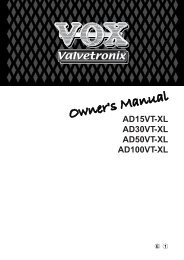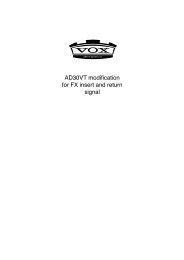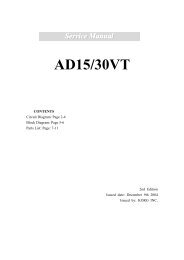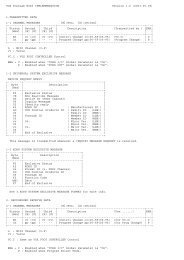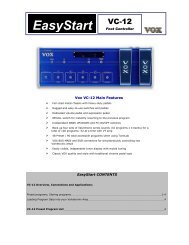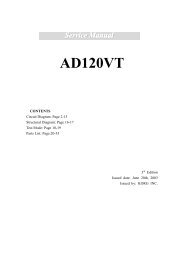ToneLab LE's manual - Vox
ToneLab LE's manual - Vox
ToneLab LE's manual - Vox
You also want an ePaper? Increase the reach of your titles
YUMPU automatically turns print PDFs into web optimized ePapers that Google loves.
LISTEN TO THE PROGRAMS<br />
8. Use the BANK UP, DOWN switches (5.1) to select a bank 1–30.<br />
Notice that the number in the bank display (3.4) blinks and changes.<br />
HINT: <strong>ToneLab</strong> LE has 120 programs, organized into 30 banks with four programs in each bank (30 x<br />
4 = 120). When shipped from the factory, banks 1–10 contain 40 programs. (The programs in<br />
banks 1–10, 11–20 and 21–30 are identical to each other) Program Select mode lets you select<br />
these programs. There’s also an effect ON/OFF mode that lets you turn individual effects on/off.<br />
9. Use the program select 1–4 switches (5.2) to select a program.<br />
The program LED you selected will light, and the number in the bank display will also change<br />
and stay lit. Go ahead and play your guitar.<br />
For example if you want to select program 3-1 (bank 3, program 1), press the BANK UP or<br />
DOWN switch to make the bank display read “3,” and then press the program select 1 switch to<br />
make the LED light.<br />
If you’re selecting a program in the same bank, simply press a program select 1–4 switch. If you<br />
want to select a program from a different bank, you’ll need to perform steps 8 and 9 in that order.<br />
NOTE: If you can’t select a program, you’re probably not in Program Select mode. Get back into Program<br />
Select mode as described in “Program Select mode” (p.22).<br />
HINT: The preset programs cover an amazing range of sounds; fat hi-gain lead sounds, nostalgic<br />
clean sounds that work best with your rhythm (neck) pickup, aggressive modern crunch sounds<br />
for heavy riffing with your lead (bridge) pickup, and much more.<br />
10. The expression pedals are assigned to control the most appropriate parameters for each<br />
program, such as wah, volume, delay, reverb input level, or other effect parameter. The<br />
CONTROL switch is assigned functions such as TAP tempo input of the delay time.<br />
11. Press and hold down the BANK UP switch for one second to turn on the switch’s green LED and<br />
to enter Effect On/Off mode. Effect On/Off mode lets you turn each effect on or off just as if you<br />
were using a set of stomp boxes. Program select 1–4 will turn the pedal, modulation, delay, and<br />
reverb on or off respectively, and the BANK DOWN switch will bypass the insert effect.<br />
SWITCHING EFFECTS ON/OFF<br />
12. The model select buttons will be lit (ON) or dark (OFF) to indicate the on/off state of each<br />
effect. If you press a button that is dark or turn the model selector, the effect will turn on and<br />
the model select button will blink. If you press a button that is blinking, the effect will turn off<br />
and the button will go dark.<br />
CREATE YOUR OWN SOUNDS<br />
13. To adjust the sound of the AMP model, use the AMP selector to select one of the sixteen<br />
amp models. Then you can simply adjust the sound pretty much in the same way as if you<br />
were really using the actual model of guitar amp you selected.<br />
Adjust the GAIN value knob 1, TREBLE value knob 3, MIDDLE value knob 4, BASS value<br />
knob 5, and the VR GAIN value knob 2 (which corresponds to the MASTER) as you like. To<br />
get the most accurate vintage tube amp distortion, raise the VR GAIN as high as possible.<br />
The CH VOLUME value knob 6 lets you adjust the volume while retaining the overall sound<br />
including the distortion produced by the Valve Reactor.<br />
If you press the CAB button while holding down the AMP button, you can then use value<br />
knob 3 to adjust the PRESENCE, value knob 4 to adjust the NR (Noise Reduction) effect,<br />
and value knob 6 to adjust the volume level of the programs (PROG LVL).<br />
Pressing the CAB button, then turning the value knob 1 lets you select a cabinet model.<br />
When you use the AMP MODEL and CABINET MODEL selectors, a different type of guitar<br />
amp will appear before your very eyes — or, should we say, ears!<br />
HINT: P.32 lists recommended combinations of amp and cabinet models but others are fine too.<br />
7




